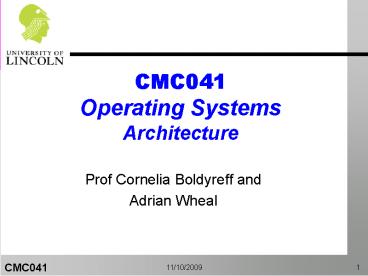CMC041 Operating Systems Architecture - PowerPoint PPT Presentation
1 / 19
Title:
CMC041 Operating Systems Architecture
Description:
Draws on all aspects of I T. Illustrates concepts in application. Outward-looking ... 22.50 (or currently 16.79 from Amazon.co.uk) Other recommended books ... – PowerPoint PPT presentation
Number of Views:102
Avg rating:3.0/5.0
Title: CMC041 Operating Systems Architecture
1
CMC041Operating SystemsArchitecture
- Prof Cornelia Boldyreff and
- Adrian Wheal
2
Course Manifesto
- Summative and Integrative
- Draws on all aspects of I T
- Illustrates concepts in application
- Outward-looking
- Based on real-world case-studies
- Windows XP, UNIX, Linux and other OSs
- First-hand
- Keyed to your experiences and ours
3
Books
- Strongly recommended
- C Ritchie, Operating Systems, 4th ed, Thomson
- ISBN 0-826-464165
- 22.50 (or currently 16.79 from Amazon.co.uk)
- Other recommended books
- Tanenbaum, Modern Operating Systems
- Dietel and Dietel, Operating Systems
- Stallings, Operating Systems
- Silbershatz and Galvin, O S Concepts
- Note The editions in the library (even if not
the latest) are fine!
4
Suggested Study Time
5
Assessment
- 5 Workshop tests 10 each
- Based on practical exercises and investigation
- Multiple choice format
- In-Class test 50
- After Easter
- Based on lectures and workshops
- Sample questions and mock test available before
Easter
6
Course Overview
- What is an Operating System?
- Introduction to the course and to OSAs
- Development of Operating Systems
- History and types of Operating System
- Basic Concepts
- Systems Architecture
- The Concept of Process
7
Course Overview (cont)
- Process Management
- Memory Management
- Extending address space, Virtual Memory
- Inter-process Communication
- Deadlock
- Input-output systems
- File systems
8
Examples of OSs
- DOS
- Windows
- Windows NT
- Mac
- VMS
- OS/9
- Palm-OS
- UNIX
- OSF/1
- Linux
- UniPlus
- OS/360
- VM
- OS/2
9
What is an operating system?
Accounts
Student Records
Library Catalogue
Compilers
Database
Network
User Interface
Operating System
Firmware and Microprogramming
Computer Hardware
10
What is an operating system?
- What does an operating system do?
- Two approaches
- The Operating System as an Extended Machine
- Beautification Principle
- Top-down (user/application centred) view
- The Operating System as Resource Manager
- Bottom-up (machine centred) view
11
OS as Extended Machine
- OS hides the implementation details
- Example the file system of a computer vs direct
programming of disk controller - A Standardised Virtual Machine across different
physical machines - allows easy program distribution
- Computer appears more beautiful than its ugly
hardware would alone
12
OS as a Resource Manager
- Allocates resources to users
- Disks, memory, network interfaces, timers,
terminals/displays, laser printers, etc - Whos using what? How is it shared?
- Maintains a multi-user illusion to several
users - Timesharing system has real multiple users
- Most systems allow several user programs
13
The Evolution of the O.S.
- 1st generation (1945-1955)
- Plugboards, valves, numerical work
- 2nd generation (1955-1965)
- Transistors, cards, punched tape, magtape
- Batch systems dominant
- 3rd generation (1965-1980)
- I.C.s and Multiprogramming
- OS360, VM, Multics, UNIX timesharing
14
Batch Jobs
EOJ
program data cards
RUN
LOAD
fortran program cards
FORTRAN
JOB 2,5 WHEAL
15
Key ideas of 3rd gen OS
- Multiprogramming
- Memory partitioned into several parts
- Different job in each partition
- Spooling
- Simultaneous Peripheral Operation On-line
- Timesharing
- Each user has interactive use
- Job pre-emption ensures fast response
16
Type of Operating System
- Single-user, single-processing
- Single-user, multi-processing
- Timesharing (Multi-user)
- Distributed (Multi-processor)
- Real-time
- Usually designed for control applications
- Require guaranteed response time
- Virtual Machine (VM)
17
4th Generation Systems (80-)
- Microcomputers
- PCs, Workstations
- Supercomputers
- Cray, CDC
- Multi-processor systems
- Distributed Systems
- Networks, client-server systems
- DOS, and UNIX dominant
18
The Digital PDP8
- Basic system
- 12-bit CPU
- 4096 word memory
- Teletype with reader/punch
- Available Software
- Paper-tape kit
- Diagnostics
- PAL (assembler)
- BASIC, 8K Fortran
The Classic PDP8 1965 price from 11,000
19
OS/8
- OS/8 developed from 1965-1977
- Needed only 8K
- Would run on disk or DECtape
- Design copied for CP/M (and DOS)
- Multos-8 offered multiple OS/8 VMs































